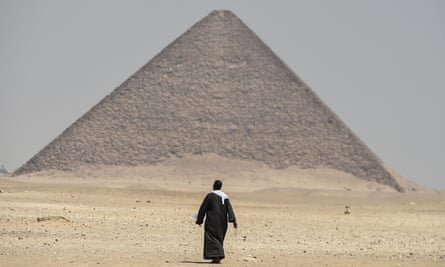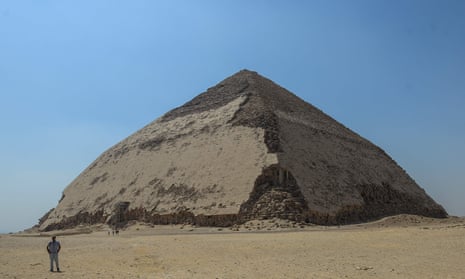Egypt has opened to visitors the “bent” pyramid built for the pharaoh Sneferu, a 101-metre structure south of Cairo that marks a key step in the evolution of pyramid construction.
Tourists will now be able to clamber down a 79-metre long, narrow tunnel from a raised entrance on the pyramid’s northern face, to reach two chambers deep inside the 4,600-year-old structure.
They will also be able to enter an adjoining 18-metre high “side pyramid”, possibly for Sneferu’s wife Hetepheres, opened for the first time since its excavation in 1956.
The “bent” Pyramid is one of three built for Fourth Dynasty founding pharaoh Sneferu in Dahshur, at the southern end of the Memphis necropolis, a Unesco world heritage site.
Its appearance is unusual. The first 49 metres, which have largely kept their smooth limestone casing, are built at a steep 54 degree angle, before tapering off towards the top. It has been reopened to the public for the first time since 1965, when it was closed for restoration works.
The angular shape contrasts with the straight sides of Sneferu’s Red Pyramid just to the north, the first of ancient Egypt’s fully formed pyramids and the next step towards the Great Pyramid of Giza.

Architects changed the angle of the “bent” pyramid when cracks started appearing in the structure, said Mostafa Waziri, secretary general of Egypt’s Supreme Council of Antiquities.
“Sneferu lived a very long time … the architects wanted to reach the complete shape, the pyramid shape,” Mohamed Shiha, director of the Dahshur site, said.
“Exactly where he was buried – we are not sure of that. Maybe in this [bent] pyramid, who knows?“
Authorities are seeking to promote tourism at Dahshur, about 28km (17 miles) south of central Cairo. The site lies in the open desert, attracts just a trickle of visitors, and is free of the touts and bustle of Giza.

As they opened the pyramids, archaeologists presented late-period mummies, masks, tools and coffins discovered during excavations that began near the Dahshur pyramids last year and are due to continue.
“When we were taking those objects out, we found … a very rich area of hidden tombs,” Waziri said.
The promotion of Dahshur is part of a wider push to boost tourism, an important source of foreign revenue for Egypt that dipped steeply after the country’s 2011 uprising but has gradually recovered.
Archaeologists also unveiled the nearby tomb of Sa Eset, which has been closed since its excavation in 1894 and contains finely preserved hieroglyphic funerary texts.
Foreign ambassadors invited to attend the archaeological announcements were led sweating into the tight spaces of the tomb, which is not expected to be opened to the public for another two years.
